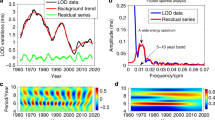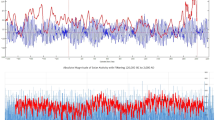Abstract
As is well known, the semidiurnal barometric oscillations indicate that the atmosphere has a free oscillation of a period of 12 hours1. On the other hand, G. I. Taylor's evidence2 from the propagation of waves of explosion points to a free period of 10½ hours. Moreover, the diurnal variation of the earth's magnetic field, when interpreted by the dynamo theory, shows3 that at the upper conducting layer the pressure oscillations are nearly 180° out of phase with the observed pressure oscillations at the ground. Also, the required conductivity of the layer is larger than the value that can be inferred from radio soundings.
This is a preview of subscription content, access via your institution
Access options
Subscribe to this journal
Receive 51 print issues and online access
$199.00 per year
only $3.90 per issue
Buy this article
- Purchase on Springer Link
- Instant access to full article PDF
Prices may be subject to local taxes which are calculated during checkout
Similar content being viewed by others
References
S. Chapman, S. K. Pramanik and J. Topping, Beiträge zur Geophysik, 33, 246 (1931).
Proc Roy. Soc., A, 126, 169 728 (1929); Mem. Roy. Met. Soc., 4, No. 35 (1932); Proc. Roy. Soc., A, 156, 378 (1936).
S. Chapman, Phil. Trans., A, 218, 1 (1919).
Quart. J. Roy. Met. Soc., 61, 285 (1935).
Proc. Roy. Soc., A, 150, 697 (1935).
Proc. Roy. Soc., A, 154, 455 (1936).
Author information
Authors and Affiliations
Rights and permissions
About this article
Cite this article
PEKERIS, C. Atmospheric Oscillations. Nature 138, 642–643 (1936). https://doi.org/10.1038/138642a0
Issue Date:
DOI: https://doi.org/10.1038/138642a0
Comments
By submitting a comment you agree to abide by our Terms and Community Guidelines. If you find something abusive or that does not comply with our terms or guidelines please flag it as inappropriate.



